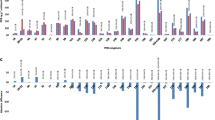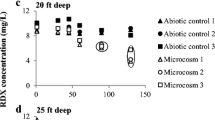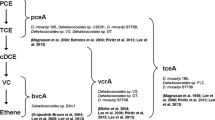Abstract
Gene probe hybridization was used to determine distribution and expression of co-metabolic genes at a contaminated site as it underwent in situ methanotrophic bioremediation of trichloroethylene (TCE). The bioremediation strategies tested included a series of air, air:methane, and air:methane:nutrient pulses of the test plot using horizontal injection wells. During the test period, the levels of TCE reduced drastically in almost all test samples. Sediment core samples (n = 367) taken from 0 m (surface)–43 m depth were probed for gene coding for methanotrophic soluble methane monooxygenase (sMMO) and heterotrophic toluene dioxygenase (TOD), which are known to co-metabolize TCE. The same sediment samples were also probed for genes coding for methanol dehydrogenase (MDH) (catalyzing the oxidation of methanol to formaldehyde) to assess specifically changes in methylotrophic bacterial populations in the site. Gene hybridization results showed that the frequency of detection of sMMO genes were stimulated approximately 250% following 1% methane:air (v/v) injection. Subsequent injection of 4% methane:air (v/v) resulted in an 85% decline probably due to nutrient limitations, since addition of nutrients (gaseous nitrogen and phosphorus) thereafter caused an increase in the frequency of detection of sMMO genes. Detection of TOD genes declined during the process, and eventually they were non-detectable by the final treatment, suggesting that methanotrophs displaced the TOD gene containing heterotrophs. Active transcription of sMMO and TOD was evidenced by hybridization to mRNA. These analyses combined with results showing the concomitant decline in TCE concentrations, increases in chloride concentration and increases in methanotroph viable counts, provide multiple lines of evidence that TCE remediation was caused specifically by methanotrophs. Our results suggest that sMMO genes are responsible for most, if not all, of the observed biodegradation of TCE. This study demonstrates that the use of nucleic acid analytical methods provided a gene specific assessment of the effects of in situ treatment technologies.





Similar content being viewed by others
References
Bowman JP, Jiménez L, Rosario I, Hazen TC, Sayler GS (1993) Characterization of the methanotrophic bacterial community present in a trichloroethylene-contaminated subsurface groundwater site. Appl Environ Microbiol 59:2380–2387
Brockman FJ, Payne W, Workman DJ, Soong A, Manley S, Hazen TC (1995) Effect of gaseous nitrogen and phosphorus injection on in situ bioremediation of a trichloroethylene-contaminated site. J Hazard Mater 41:287–298
Burrow KJ, Cornish A, Scott D, Higgins IJ (1984) Substrate specificities of the soluble and particulate methane monooxygenase of Methylosinus trichosporium OB3b. Mol Microbiol 5:3327–3333
Cardy DLN, Laidler V, Salmond GPC, Murrell JC (1991) The methane monooxygenase gene cluster of Methylosinus trichosporium: cloning and sequencing of the mmoC gene. Arch Microbiol 156:477–483
Eddy CA, Looney BB, Hazen TC, Nichols RL, Fliermans CB, Parker WH et al. (1993) Post-test evaluation of the geology, geochemistry, microbiology, and hydrology of the in situ air stripping demonstration site at the Savannah River Site. WSRC-TR-93-369. Westinghouse Savannah River Company, Aiken, SC
Enzien MV, Picardal F, Hazen TC, Arnold RG, Fliermans CB (1994) Reductive dechlorination of trichloroethylene and tetrachloroethylene under aerobic conditions in a sediment column. Appl Environ Microbiol 60:2200–2204
Frostegard A, Courtois S, Ramisse V, Clerc S, Bernillon D, Le Gall F et al (1999) Quantification of bias related to the extraction of DNA directly from soils. Appl Environ Microbiol 65:1248–5409
Grosse S, Laramee L, Wendlandt KD, McDonald IR, Miguez CB, Kleber HP (1999) Purification and characterization of the soluble methane monooxygenase of the type II methanotrophic bacterium Methylocystis sp strain WI 14. Appl Environ Microbiol 65:3929–3935
Hazen TC (1991) Test plan for in situ bioremediation demonstration of the Savannah River Integrated Demonstration Project DOE/OTD TTP No.: SR 0566–01
Hazen TC (1999) Case study: full-scale in situ bioremediation demonstration (methane biostimulation) of the Savannah River Site Integrated Demonstration Project. In: Adriano DC, Bollag JM (eds) Bioremediation of contaminated soils
Lee SW, Keeney DR, Lim DH, Dispirito M, Semrau JD (2006) Mixed pollutant degradation by Methylosinus trichosporium OB3b expressing either soluble or particulate methane monooxygenase: can the tortoise beat the hare? Appl Environ Microbiol 72:7503–7509
McDonald IR, Murrell JC (1997) The methanol dehydrogenase structural gene mxaF and its use as a functional gene probe for methanotrophs and methylotrophs. Appl Environ Microbiol 63:3218–3224
McDonald IR, Kenna EM, Murrell JC (1995) Detection of methanotrophic bacteria in environmental samples with the PCR. Appl Environ Microbiol 61:116–121
McDonald IR, Uchiyama H, Kambe S, Yagi O, Murrell JC (1997) The soluble methane monooxygenase gene cluster of the trichloroethylene-degrading methanotroph Methylocystis sp. strain M. Appl Environ Microbiol 63:1898–1904
McDonald IR, Bodrossy L, Chen Y, Murrell JC (2008) Molecular ecology techniques for the study of aerobic methanotrophs. Appl Environ Microbiol 74:1305–1315
Neufeld JD, Schafer H, Cox MJ, Boden R, McDonald IR, Murrell JC (2007) Stable-isotope probing implicates Methylophaga spp and novel Gammaproteobacteria in marine methanol and methylamine metabolism. ISME J 1:480–491
Ogram A, Sun WH, Brockman FJ, Fredrickson JK (1995) Isolation and characterization of RNA from low-biomass deep-subsurface sediments. Appl Environ Microbiol 61:763–768
Oldenhuis R, Janssen DB (1993) Degradation of trichloroethylene by methanotrophic bacteria. In: Murrell JC, Kelly DP (eds) Microbial growth on C1 compounds. Intercept Ltd, Andover, pp 121–133
Oldenhuis R, Vink LJM, Janssen DB, Witholt B (1989) Degradation of chlorinated hydrocarbons by Methylosinus trichosporium OB3b expressing soluble monooxygenase. Appl Environ Microbiol 55:2819–2826
Pfiffner SM, Palumbo AV, Phelps TJ, Hazen TC (1997) Effects of nutrient dosing of subsurface methanotrophic populations and trichloroethylene degradation. J Ind Microbiol Biotechnol 18:204–212
Phelps TJ, Niedzielski JJ, Schram RM, Herbes SE, White DC (1990) Biodegradation of trichloroethylene in continuous-recycle expanded-bed bioreactors. Appl Environ Microbiol 56:1702–1709
Sayler GS, Fleming JT, Nivens DE (2001) Gene expression monitoring in soils by mRNA analysis and gene lux fusions. Curr Opin Biotechnol 12:455–460
Semprini L, Hopkins GD, Roberts PV, McCarty PL (1992) Pilot scale field studies of in situ bioremediation of chlorinated solvents. J Hazard Mater 32:145–162
Shannon D, Lawson S, Macy JM (1995) Bioremediation consortium to tackle chlorinated solvents Bioremediation of selenite in oil refinery waste-water. Environ Sci Technol 29:762–765
Shigematsu T, Hanada S, Eguchi M, Kamagata Y, Kanagawa T, Kurane R (1999) Soluble methane monooxygenase gene clusters from trichloroethylene-degrading Methylomonas sp strains and detection of methanotrophs during in situ bioremediation. Appl Environ Microbiol 65:5198–5206
Shingleton JT, Applegate BM, Nagel AC, Bienkowski PR, Sayler GS (1998) Induction of the tod operon by trichloroethylene in Pseudomonas putida TVA8. Appl Environ Microbiol 64:3445–5049
Theisen AR et al (2005) Regulation of methane oxidation in the facultative methanotroph Methylocella silvestris BL2. Mol Microbiol 58:682–692
Travis BJ, Rosenberg ND (1997) Modeling in situ bioremediation of TCE at Savannah River: effects of product toxicity and microbial interactions on TCE degradation. Environ Sci Technol 31:3093–3102
Tsien HC, Hanson RS (1992) Soluble methane monooxygenase component B gene probe for identification of methanotrophs that rapidly degrade trichloroethylene. Appl Environ Microbiol 58:953–960
Van Hamme JD, Singh A, Ward OP (2003) Recent advances in petroleum microbiology. Microbiol Mol Biol Rev 67:503–549
Zylstra GJ, Wackett LP, Gibson DT (1989) Trichloroethylene degradation by Escherichia coli containing the cloned Pseudomonas putida f1 toluene dioxygenase genes. Appl Environ Microbiol 55:3162–3166
Acknowledgments
This work was supported by the U.S. Department of Energy under Contract Nos. DE-AC02-05CH11231 and DE-AC06-76RLO-1830, and contracts from Westinghouse Savannah River Co. to the University of Tennessee. John P. Bowman was supported by the Environics Directorate, Armstrong Laboratories, Tyndall AFB, Panama City, FL, U.S. Air Force Office of Scientific Grants. We would like to thank Bruce Applegate for valuable technical assistance.
Author information
Authors and Affiliations
Corresponding author
Additional information
Communicated by Erko Stackebrandt.
Rights and permissions
About this article
Cite this article
Hazen, T.C., Chakraborty, R., Fleming, J.M. et al. Use of gene probes to assess the impact and effectiveness of aerobic in situ bioremediation of TCE. Arch Microbiol 191, 221–232 (2009). https://doi.org/10.1007/s00203-008-0445-8
Received:
Revised:
Accepted:
Published:
Issue Date:
DOI: https://doi.org/10.1007/s00203-008-0445-8




